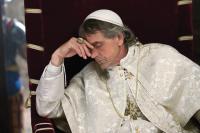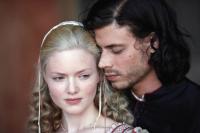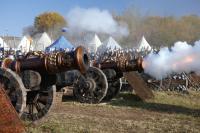The Borgias
Published in Early Modern History (1500–1700), General, Issue 6 (Nov/Dec 2011), Reviews, Volume 19
The series begins with the election of Rodrigo Borgia (Jeremy Irons) as Pope Alexander VI in 1492.
Neil Jordan’s much-heralded family saga of Renaissance ambition, murder and debauchery has more to do with historical reputation than actual fact. However much scholarship proves the opposite, good stories never die. And, as so often, it’s the victors who tell them. When Cardinal Giuliano della Rovere finally succeeded as Pope Julius II in 1503, and crushed Cesare Borgia shortly after, many long-standing opponents of the Borgias’ consolidation of the Papal States took the opportunity to rewrite their ten-year rule. Their lurid stories, later picked up and amplified by generations of Protestant and anti-clerical writers into a mythology, are now hard to dispel.The series begins with the election of Rodrigo Borgia (Jeremy Irons) as Pope Alexander VI in 1492. He was not a Spanish upstart but a papal insider who was already vice-chancellor of the Holy See and whose uncle Alfonso had been Pope Calixtus III (1455–8). No rivals were poisoned to obtain the post, nor was it an issue of simony—the buying of ecclesiastical office—as the first episode depicts. What gave rise to subsequent problems were not just disappointed rivals, most notably Cardinal della Rovere, or even the new pope’s many relatives (nepoti) looking for jobs, but above all a decisive historical conjuncture in Italian and European politics.This screen version gives the false impression that Alexander’s election brought about the foreign invasion of Italy. In fact it was the tense situation that made the papal election so tight. The rough balance of power, which had for 40 years preserved peace in Italy between Milan, Venice, Florence, Naples and the papacy, was breaking down. In these circumstances it was plain that Rodrigo Borgia was chosen as the politician most likely to maintain the integrity of the Papal States and the independence of Italy. It wasn’t della Rovere courting the French king to depose the pope and reform the church that brought about the invasion but the death of the king of Naples without a legitimate heir and the designs of Charles VIII, the young king of France, to pursue his dynastic claim there. Venice is left out of this storyline but it was at the height of its power and its threat to Milan encouraged its ruler, Ludovico Sforza, to invite the French in!

Jordan’s Lucrezia (Holliday Grainger) is a marvellous creation—a Lolita-esque figure on whom her brother Cesare (François Arnaud, right) has a crush.
These complicated politics are simplified for viewers by lectures by Pope Alexander, once using a map fresco—like one of those made a century later for the Gallery of Maps in the Vatican—and on another occasion with the assistance of the leg of Giulia Farnese, his mistress. In an age of dynastic politics, Pope Alexander’s children were a strength. He used Cesare to strengthen his hand in the church, first as a bishop and then as a cardinal; likewise he attempted to shore up the Neapolitans by marrying his young son Jofre into their royal family, and to keep the Sforzas onside by giving the thirteen-year-old Lucrezia in marriage to Giovanni, lord of Pesaro. Jordan’s Lucrezia (Holliday Grainger) is a marvellous creation—a Lolita-esque figure on whom Cesare has a crush. Her marriage is developed as a black comedy with her having to count the thrusts of her country bumpkin husband. The pope arranged for an annulment—not because Giovanni was cruel to her but because he proved to be of so little value politically or militarily. This was granted on the grounds of non-consummation and the sex element is played out again before the cardinals and canon lawyers for all it’s worth. Spurned Sforza had his revenge by later inventing an incestuous relationship between Lucrezia and Cesare. Juan Borgia, duke of Gandia in Spain, was the pope’s favourite son; his louche and luxurious lifestyle was hated, and his corpse was eventually found floating in the Tiber. But he wasn’t commander of the papal armies against Charles VIII of France in 1494, nor was he the murderer of Djem, the hostage Turkish prince. The latter actually died—probably of natural causes—after having been handed over to the French. In these as in a number of other cases the screenwriters have jumbled history to suit their plot.The other great creation is the French king, a caricature like something out of Blackadder. He is here a barbarian warlord approaching middle age whom Pope Alexander is forced to crown king of Naples. The reality was that the pope beguiled an impressionable young man first by treating him as an equal and then by frustrating him, offering little more than a cardinal’s hat for one of the French hierarchy in his entourage and the opportunity to make use of the Turkish pretender for a putative crusade. The continuation of King Charles and his army to Naples seems to me a missed television opportunity! This series has them dying of the plague. In fact it was an epidemic outbreak of syphilis, allegedly brought back from the recently discovered New World, and soon to be known to the rest of Europe from the retreating soldiers who carried it as ‘the French disease’. The French invasion also brought the so-called ‘military revolution’. Charles had an extensive artillery train to batter down the Italians’ medieval-style fortifications but it was not much use in the open field, as depicted in one farcical battle-scene. It took another 130 years of technical innovation and Gustavus Adolphus’s tactical genius to make cannon into an effective battlefield weapon. On the other hand, The Borgias does get the duel right. No fancy fencing by Cesare as he fights and kills a husband of one of his lovers—just the use of the sword in one hand and a stiletto in the other.

King Charles VIII of France had an extensive artillery train to batter down the Italians’ medieval-style fortifications but it was not much use in the open field, as depicted in one farcical battle-scene. It took another 130 years of technical innovation and Gustavus Adolphus’s tactical genius to make cannon into an effective battlefield weapon. (All images: Sky Atlantic)
Apart from the pope himself, who was rotund and ebullient and not at all like the elegant Mr Irons, these characters are well cast with look-alike actors. Savonarola, Machiavelli, Lucrezia, Charles VIII, della Rovere and especially Cesare Borgia—supposedly the most handsome man of his time—all bear fair resemblances to contemporary portraits. The clothes and interiors are well done, and huge expense has gone into recreating the Vatican of the period and the Borgia Palace. Most recognisable is the candy-striped Santa Croce in Florence, where Savonarola denounced the corruption of the papacy in his doomsday sermons. Never since the comedy sketches of the late Dave Allen has the confessional box been used with such frequency as a prop. Unfortunately it was not invented until 1565 and so is not in the diary of Johannes Burchard, the papal master of ceremonies, one of the main sources of information. He features here as a bookish legal adviser to Alexander whenever he needs an obscure precedent to justify the latest immorality! What definitely isn’t right is Rome itself. It wasn’t all Renaissance but a city in transition, with medieval tower-houses, classical ruins, open spaces with grazing animals, and churches and palaces old and new all thrown in together. The other problem is the light, scenery and greenery—quite obviously not Italy. The overall effect in exterior shots is regrettably more Tales from Europe than Pier Paolo Pasolini. HI
Hiram Morgan lectures in history at University College Cork.
















